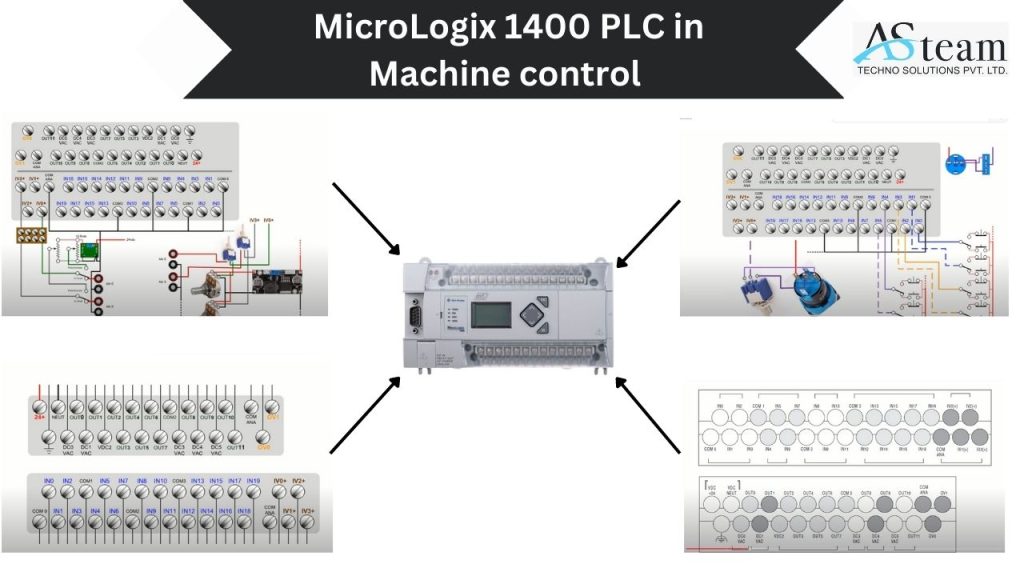Because of its versatility, ease of use, and low cost, the MicroLogix 1400 PLC is frequently utilized for machine control in a variety of sectors. The MicroLogix 1400 PLC can be used for machine control in the following ways.
Motor control:
The process of controlling the speed, direction, and torque of an electric motor is known as motor control. Electric motors are frequently utilised in machines, automobiles, and other applications, hence it is an important part of industrial automation.
Motor control can be accomplished by a variety of means, including:
- Direct on line (DOL) starting: The motor is directly linked to the power supply in this way, and the entire voltage is applied to start the motor. This method is straightforward and low-cost, however it might result in large beginning currents and mechanical stress on the motor.
- Soft starting: To avoid large starting currents and mechanical stress, soft starting entails gradually increasing the voltage delivered to the motor. This procedure is more expensive, but it can increase motor life and minimize energy use.
- Variable frequency drive (VFD): A variable frequency drive (VFD) is an electronic device that controls the speed and torque of an electric motor by adjusting the frequency of electricity supplied to the motor. This technology is frequently utilized in industrial automation since it allows for accurate control of motor speed while also lowering energy usage.
Sensor control:
Sensor control is an essential component of industrial automation because it enables machines and systems to respond to environmental changes while remaining efficient. Sensor control can be achieved in a number of ways, including:
- Programmable logic controllers (PLCs): Rockwell Automation PLCs are devices that can receive sensor input signals and process them to provide system control signals. PLCs are commonly employed in industrial automation because they can provide accurate system control and can be configured to do complex tasks.
- Analog signals: Analogue sensors generate a continuous output signal that varies with the variable being monitored. Analogue electronics can be used to process the signal and generate a control signal for the system.
- Digital signals: Digital sensors produce a binary output signal that indicates the presence or absence of the measured variable. The signal can be processed using digital electronics to provide a control signal for the system.
Conveyor control:
The process of controlling the operation of conveyors in an industrial automation system is known as conveyor control. Conveyors are commonly used to convey goods, raw materials, and other items from one point to another in manufacturing, material handling, and logistics.
- On/off control: Turning the conveyor motor on and off to start and stop the conveyor is what on/off control is all about. This system is simple and affordable, but it allows very limited control over the conveyor’s speed and direction.
- Variable frequency drive (VFD) control: By altering the frequency of the power provided to the motor, VFDs can be utilised to adjust the speed of the conveyor. This method gives you fine control over the speed and can help you save energy.
- Programmable logic controllers (PLCs): PLCs can be utilized to control the conveyor’s operation by monitoring sensors and controlling the motor as well as other devices like brakes and limit switches. This approach gives the conveyor advanced control and may be programmed to do complex jobs.
Conveyor control may also include the use of sensors to detect the presence of items or materials on the conveyor as well as the functioning of additional devices such as diverters, stoppers, and sensors.
Also check: Rockwell Automation 1766-L32BXB MicroLogix 1400 PLC
Data logging:
The process of gathering and storing data from numerous sensors and devices in an industrial automation system is known as data logging. Data logging is an important part of industrial automation because it allows operators and managers to monitor system performance and detect trends and abnormalities.
Data logging can be accomplished through a variety of means, including.
- Manual data logging: Operators manually record data from sensors and devices at regular intervals in this manner. This procedure is easy and inexpensive, but it takes time and is prone to errors.
- Computer-based data logging: Computer-based data logging entails automatically collecting and storing data from sensors and devices using a computer or data logger. This technology, which may enable real-time data analysis and visualisation, is more accurate and efficient than manual data logging.
- Programmable logic controllers (PLCs): Using data logging instructions in the PLC programming language, PLCs may gather and store data from sensors and devices. This approach allows for advanced data logging and can be combined with other PLC control features.
Read: 4 Common Questions About Sweden VPS Hosting Answered
Data logging is useful in a variety of industrial automation applications, such as process control, environmental monitoring, and machine monitoring. The technique of data logging used is determined by the application and the level of data analysis and visualisation required.
Overall, the MicroLogix 1400 PLC is a versatile and dependable machine control solution for a variety of industries such as manufacturing, packaging, material handling, and food and beverage.





